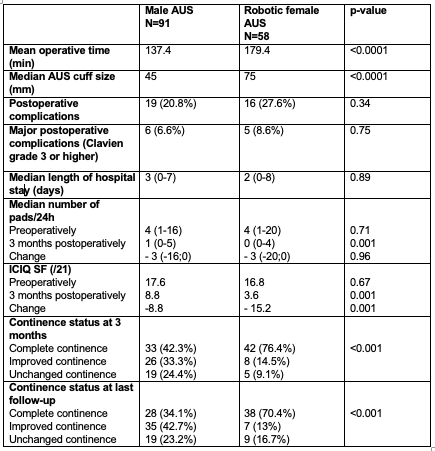Back
Poster, Podium & Video Sessions
Podium
PD06: Urodynamics/Lower Urinary Tract Dysfunction/Female Pelvic Medicine: Female Incontinence: Therapy I
PD06-08: Robotic female artificial urinary sphincter implantation vs male artificial urinary sphincter implantation for non-neurogenic stress urinary incontinence
Friday, May 13, 2022
10:40 AM – 10:50 AM
Location: Room 255
benoit peyronnet*, Alexandre Dubois, valentine lethuillier, rennes, France, Imad bentellis, nice, France, Quentin vesval, camille haudebert, claire richard, romain mathieu, lucas freton, mehdi el-akri, karim Bensalah, Andrea Manunta, juliette Hascoet, rennes, France
- BP
Podium Presenter(s)
Introduction: In 2006, Ananias Diokno and is team reported what remains to date the only series comparing male vs female artificial urinary sphincter (AUS) implantation suggesting better functional outcomes and longer device survival for female implantations (Petero VG, J Urol 2006). We hypothesize that the rapidly spreading robotic approach for female implantation may have changed this comparison. The aim of this study was to compare the outcomes of robotic female AUS vs male AUS implantation for non-neurogenic SUI.
Methods: The charts of all male patients who had an AUS implantation and of all female patients who underwent robotic AUS implantation between 2008 and 2020 for non-neurogenic SUI at a single center were reviewed retrospectively. All the implantations were performed by three surgeons in their learning curves over the study period. All the female implantations were performed using a robotic “anterior” transperitoneal approach. The primary endpoint was the continence status at 3 months categorized as: complete resolution of SUI (0 pad), improved SUI or unchanged SUI.
Results: After exclusion of 19 neurogenic patients, 149 patients were included: 58 women and 91 men. The operative time was significantly shorter in the male group (137.4 vs. 179.4 min; p<0.0001). The postoperative complications rate was similar in both groups (20.8% vs. 27.6%; p=0.34) as was the median length of hospital stay (3 vs. 2 days; p=0.89). The continence status at 3 months and at last follow-up favored the female group (p < 0.001; see table). The ICIQ-SF decrease at 3 months was significantly greater in the female group (-8.8 vs. -15.2; p=0.001). The 5-year estimated explantation-free survival was similar in both groups (78.2% vs. 74.6%; p=0.69) as well as the 5-year estimated revision-free survival (78.7% vs. 69.3%; p=0.30)
Conclusions: Robotic female AUS implantation and male AUS implantation have similar morbidity and similar device survivals but female AUS implantation may be associated with better functional outcomes which would confirm previous findings (Petero VG, J Urol 2006)
Source of Funding: none

Methods: The charts of all male patients who had an AUS implantation and of all female patients who underwent robotic AUS implantation between 2008 and 2020 for non-neurogenic SUI at a single center were reviewed retrospectively. All the implantations were performed by three surgeons in their learning curves over the study period. All the female implantations were performed using a robotic “anterior” transperitoneal approach. The primary endpoint was the continence status at 3 months categorized as: complete resolution of SUI (0 pad), improved SUI or unchanged SUI.
Results: After exclusion of 19 neurogenic patients, 149 patients were included: 58 women and 91 men. The operative time was significantly shorter in the male group (137.4 vs. 179.4 min; p<0.0001). The postoperative complications rate was similar in both groups (20.8% vs. 27.6%; p=0.34) as was the median length of hospital stay (3 vs. 2 days; p=0.89). The continence status at 3 months and at last follow-up favored the female group (p < 0.001; see table). The ICIQ-SF decrease at 3 months was significantly greater in the female group (-8.8 vs. -15.2; p=0.001). The 5-year estimated explantation-free survival was similar in both groups (78.2% vs. 74.6%; p=0.69) as well as the 5-year estimated revision-free survival (78.7% vs. 69.3%; p=0.30)
Conclusions: Robotic female AUS implantation and male AUS implantation have similar morbidity and similar device survivals but female AUS implantation may be associated with better functional outcomes which would confirm previous findings (Petero VG, J Urol 2006)
Source of Funding: none


.jpg)
.jpg)